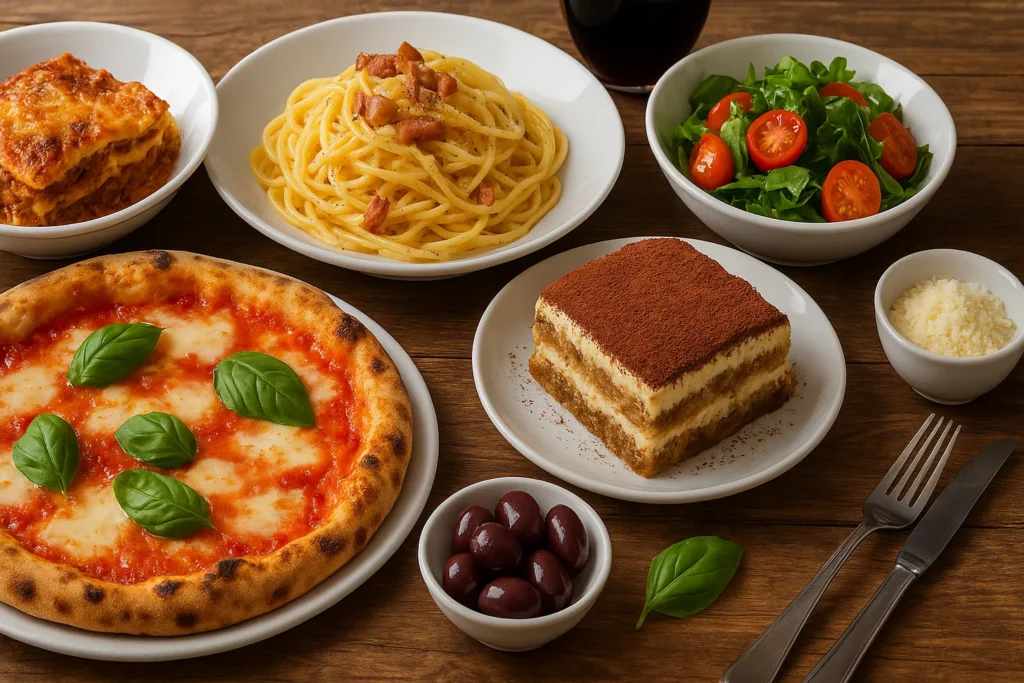
If you’ve ever taken a bite of pasta so perfect it made you question every meal you’ve had before, congratulations — you’ve experienced a small piece of Italian magic. Italy doesn’t just cook; it celebrates food. Each dish is a love letter to tradition, crafted with care, passed down through generations, and served with enough passion to power a Vespa. From the rolling vineyards of Tuscany to the coastal kitchens of Sicily, Italian cuisine is not just about eating — it’s about living deliciously.
The Secret Ingredient: Simplicity with Soul
Italian food has a secret weapon, and it’s not hidden in a fancy sauce. It’s simplicity. Italians believe that if you use the freshest ingredients and respect them, the dish practically cooks itself. Olive oil, ripe tomatoes, garlic, basil — just four humble ingredients that, when combined, create something symphonic. The trick is not to overcomplicate. As every Italian nonna (grandmother) will tell you, “less is more — unless it’s cheese.”
Regional Flavors: A Culinary Map of Italy
One of the most fascinating things about Italy is how dramatically the cuisine changes from region to region. Think of it as a patchwork quilt of flavors, stitched together by history and geography.
- Northern Italy loves butter, cream, and rice. Dishes like risotto and polenta dominate, and you’ll find rich sauces made with truffles and mushrooms.
- Central Italy is pasta paradise — think tagliatelle, lasagna, and hearty meat sauces simmered for hours.
- Southern Italy? The kingdom of tomatoes, olive oil, and sunshine. Here you’ll find pizza in Naples, seafood in Sicily, and enough lemons in the Amalfi Coast to perfume the whole Mediterranean.
Each bite tells a story — one of landscape, climate, and centuries of tradition.
The Art of the Italian Meal
An Italian meal isn’t just “eating.” It’s a social performance. The courses arrive like acts in a play — each one with purpose and timing.
- Antipasto – small bites to tease your appetite (think cured meats, cheeses, olives).
- Primo – the first course, usually pasta or risotto.
- Secondo – the main course, often meat or fish.
- Contorno – side dishes, usually vegetables or salad.
- Dolce – dessert, because ending without sweetness would be tragic.
And of course, it’s all accompanied by wine, conversation, and enough hand gestures to make an opera conductor jealous.
Nonna Knows Best: The Guardians of Tradition
Every Italian family has at least one nonna whose cooking is legendary. She doesn’t need recipes — just instincts, love, and possibly a wooden spoon with mysterious powers. These grandmothers are the true protectors of Italian food heritage. They remind us that cooking isn’t about following steps; it’s about following heart. When Nonna stirs her sauce, she’s stirring history itself.
Iconic Dishes That Define Italy
Italy has gifted the world a menu of icons. Some are simple, others refined, but all are unforgettable.
- Pizza Napoletana – Born in Naples, it’s a masterpiece of dough, tomato, mozzarella, and fire.
- Pasta Carbonara – The Roman classic: eggs, pecorino, guanciale, and a dash of black pepper. No cream, ever — that’s the rule!
- Lasagna al Forno – Layers of pasta, sauce, and cheese so good they could negotiate world peace.
- Tiramisu – Literally “pick me up,” this dessert does just that with coffee-soaked ladyfingers and mascarpone heaven.
Each dish is a story of place, passion, and the people who made it timeless.
The Italian Philosophy: Eat with Joy, Not Guilt
Perhaps the most beautiful part of Italian food culture is its mindset. Italians don’t count calories — they count memories. Meals are meant to be savored slowly, shared generously, and enjoyed fully. The Italian table is a place of laughter, warmth, and connection — proof that food can nourish the soul just as much as the body.
Why Italian Food Will Never Go Out of Style
Italian cuisine is timeless because it never tries too hard. It doesn’t chase trends — it sets them. It’s rustic yet elegant, humble yet heavenly. Whether you’re cooking at home or dining in a trattoria by the sea, Italian food reminds us that the best things in life are often the simplest: good ingredients, good company, and a lot of love.
So next time you twirl your spaghetti or bite into a slice of pizza, remember — you’re not just eating. You’re taking part in a tradition that has survived empires, crossed oceans, and conquered hearts worldwide. And that, dear reader, is what makes Italy’s food truly timeless.
